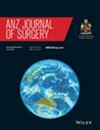Patient body composition (BC) has been shown to help predict clinical outcomes in rectal cancer patients. Artificial intelligence algorithms have allowed for easier acquisition of BC measurements, creating a comprehensive BC profile in patients using data from an entire three-dimensional (3D) region of the body. This study has utilized AI technology to measure BC from the entire lumbosacral (L1-S5) region and assessed the associations between BC and clinical outcomes in rectal cancer patients who have undergone neoadjuvant therapy followed by surgery.
A retrospective, cross sectional analysis was performed on locally advanced rectal cancer (LARC) patients treated with neoadjuvant long-course chemoradiotherapy followed by curative resection with total mesorectal excision at a tertiary referral centre, Western Health, Melbourne, Australia. A pre-trained and validated in-house AI segmentation model was used to automatically segment and measure intramuscular adipose tissue (IMAT), visceral adipose tissue (VAT), subcutaneous adipose tissue (SAT) and skeletal muscle (SM) from CT slices across the entire L1–S5 level of each patient. Multivariate analysis between patient BC and clinical outcomes was performed.
Two hundred and fourteen patients were included in the study. One hundred and fifty-one (70.6%) patients were male and 63 (29.4%) patients were female. The average age at diagnosis was 62.4 (±12.7) years. SM density, but not volume, was associated with better overall survival (OS) (HR 0.24, P = 0.029), recurrence-free survival (RFS) (HR 0.45, P = 0.048) and decreased length of stay (LoS) (HR 1.58, P = 0.036). Both IMAT volume (HR 0.13, P = 0.008) and density (HR 0.26, P = 0.006) were associated with better OS.
This study measured 3D BC from the entire lumbosacral region of rectal cancer patients. SM density was the most significant BC parameter, and was associated with improved OS, RFS and LoS. This adds to growing evidence that SM is a key component of BC in cancer patients and should be optimized prior to treatment. IMAT was also a prognostic factor, giving rise to avenues of future research into the role of adiposity on nutrition and tumour immunology.


